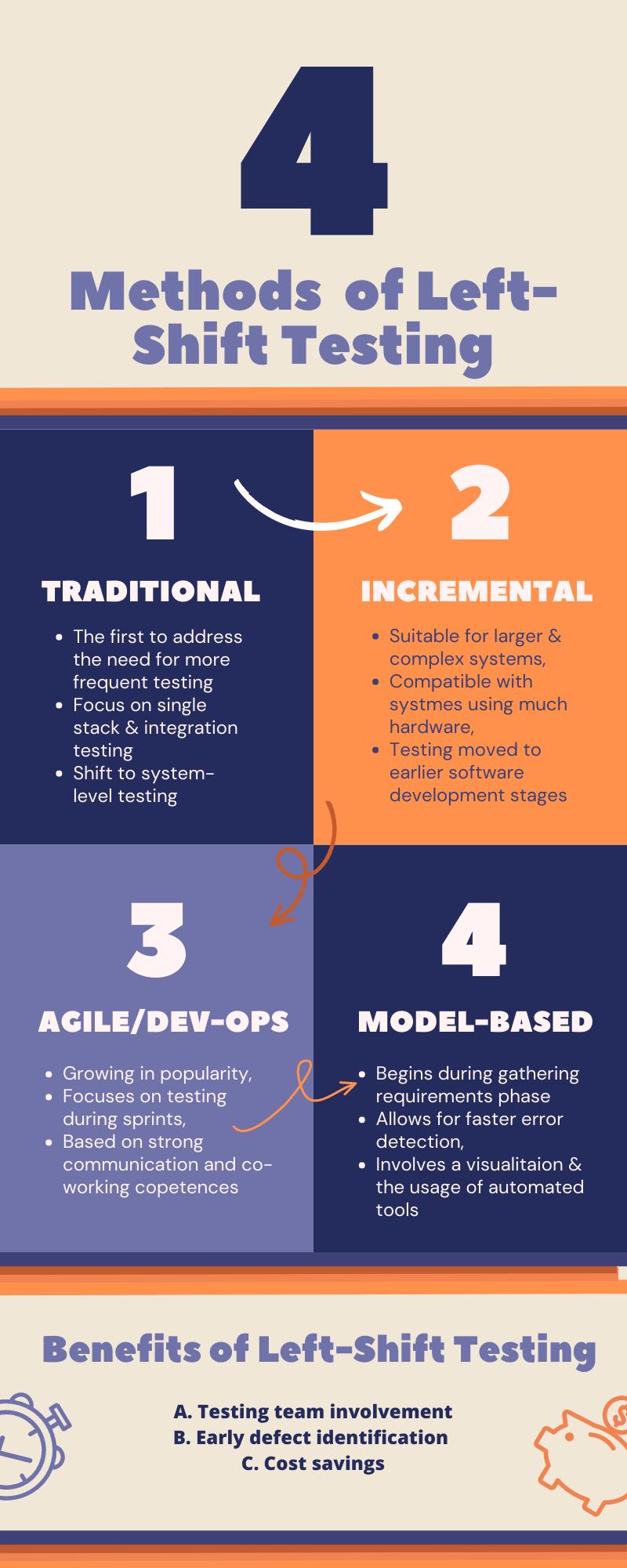
Shift Left Testing - How to Optimise the Software Testing Process
When developing software, we want its performance and quality to go hand in hand with cost reduction. How can we facilitate this process? The solution may be the shift-left testing approach, thanks to which we can find defects at the early stages of software development. Today we will discuss in detail the risks that a tester must face during project execution - and how "shift left testing" allows us to optimize the work cycle.
What you will learn:
- The risks of testing in the Waterfall Model
- How the Agile routine impacts the testing process
- How shift-left testing facilitates the overall development process
- Four methodologies of shift-left testing
- Conclusion
Testing Risks - The Waterfall Model
In the waterfall model (Waterfall), where the next phase of the project follows each other, the testing phase comes after the planning, analysis, design, and development phases. Thus, we can visualize the testing process is shifted to the right in the queue, right behind the preceding steps.
In practice, it means that defects detection takes place quite late on an already finished product. Consequently, their repair is expensive, time-consuming, and burdened with the risk of changes affecting already finished elements.
The Risks During Software Testing - Agile Methodologies
The risk is quite similar in today's popular agile methodologies (e.g. Scrum). However, the difference lies within the cyclical nature of such a method. While working in so-called "sprints," testing is done at each stage of product development. Doing so allows you to identify the underlying problem faster than when grappling with the enormity of bugs in the final version.
For a software tester, time is always of the essence. When a developer extends their work on a particular functionality, the tester must wait to begin their work. Consequently, the time allotted for testing becomes shorter, leading to situations where a defect is discovered, but the developer needs more time to correct it - not to mention the time for retesting by the testing team. Such time constraints can have a negative impact on the product's quality, and one may become careless due to the overwhelming pressure.
Shifting Left - Or How to Optimize Software Testing
To avoid such situations, it is imperative to establish a testing procedure at the outset of software development, rather than waiting until programming has commenced. By doing so, the QA team can identify errors in business logic at an early stage of product development. Rectifying defects during the documentation phase is significantly more cost-effective than doing so during development.
If the system requires reconstruction, it could delay its release and significantly increase costs. For instance, if two critical functional components of the system are found to be mutually exclusive after development and implementation, we would have to bear the cost of re-analyzing, developing, and retesting those components. Another equally illustrative example is accessibility testing. Engaging a QA team during the design stage to verify mockups, such as the readability of elements, can help avoid the costs of improving them later on.
To sum up, shift-left testing can benefit the testers’ workflow by:
- Better collaboration
- Improved communication
- Increased efficiency
- Reduced risk of project delays or failures
- Valuable feedback and insights
- Improved quality of the final product
- Seamless work between developers and testers
- Development of software with quality and efficiency in mind
4 Methods Of Shift-Left Testing
Among the tests based on shift-left methodology, we can distinguish four subtypes. Their order illustrates the chronological progression of this methodology. Each of them also has a slightly different application depending on the project for which they are intended.

Traditional Shift-left Testing
Traditional Shift-Left testing methodology has emerged as the first response to the need for more detailed software testing. This methodology shifts the focus to single-stack testing and integration testing with the help of API testing. As a result, we see a shift in the weight of the overall process to system-level testing.
Incremental Shift-left Testing
Over time, traditional shift-left testing has evolved into incremental testing. It is a methodology suitable for large and complex systems, especially those that use large amounts of hardware. Testing activities are gradually moved to earlier stages of software development, starting from the development phase and moving back to earlier stages.
Agile/DevOps Shift-left Testing
This form of testing has been gaining popularity in recent years due to its ability to react early to bugs in the software under design. Agile/DevOps Shift Left Testing emphasizes continuous and frequent testing over multiple sprints during software development; the process relies heavily on good communication and cooperation from each team member.
Model-Based Shift-left Testing
The process of model-based testing begins during the initial phase of gathering requirements. By adopting this approach, problem areas in the code can be identified and resolved even before the actual software development commences. Testers employ a visual model to represent the software's behavior and run automated tools to test the model. This method enables them to test various scenarios and ensure the design is robust and reliable before starting the development process.
source: https://www.adservio.fr/post/benefits-types-of-shift-left-testing
Conclusion
Ensuring the quality of software development is crucial, and conducting frequent testing in the early stages is the key. This approach not only facilitates the testing team's early involvement in the project but also aids in the speedy identification of defects, thus averting the need for expensive repairs or reconstruction in the final product.
Are you interested in the topic of software testing? Check out our other posts:
- What is TDD?
- Code refactoring - when an application needs improvement
- What is Proof of Concept in software development?
Share this post:

Stay updated with new posts
Get notifications when new articles are posted. You can always unsubscribe from the list.
Softnauts is committed to processing the above information. Read Privacy Policy

